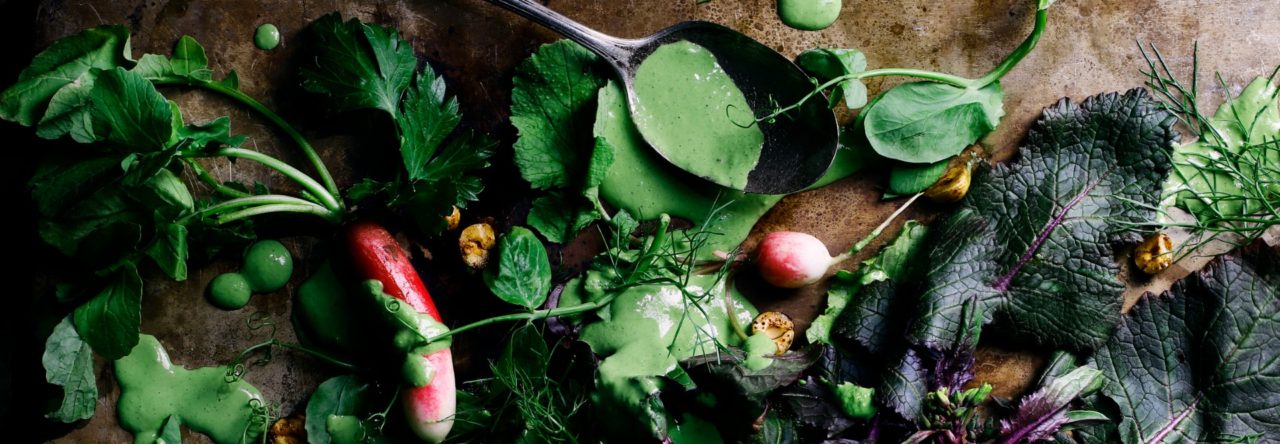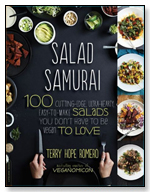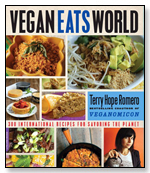Testers: Currently I don’t have an illustration for the filo, so just follow the instructions.
Moroccan Vegetable Filo Pie (Bisteeya)
Serves 6 to 8
Bisteeya (or Bastilla or Pastilla) is a glorious show-off filo pastry, a large round pie made of layers of filo and toasted almonds that encase a creamy and hearty filling that’s both savory and a little bit sweet. It’s often really huge and baked in enormass pans, but for our purposes a springform pan does a nice job at containing the pie to a generously sized treat for a cozy dinner. It’s a dish best reserved for holidays and gatherings or anywhere you’ll have a crowd ready for an unexpected surprise. Bisteeya pie is traditionally stuffed with pigeon, but we’ll use the internationally accepted vegan substitute for the dear bird: combination of cauliflower and chickpeas. Many eggs are traditionally used to bind the pie, but instead a creamy blend of tofu and almond milk steps up to do the job. A touch of saffron gives the filling a golden glow, and the top is dusted with an unexpected flourish of powdered sugar and cinnamon for a play on sweet and savory flavors.
Make bisteeya when you have a few hours set aside. It’s also possible to spread the construction of the ingredients over a day or two, or have a friend come over and help you out with the preperation of the vegetables and layering of the filo. You can assemble the whole pie and keep it chilled for about 4 hours prior to baking, which is helpful since bisteeya should be relished warm out of the oven.
Note: Follow the filo handlling advice for baklava on page XX.
Creamy sauce
1 cup plain almond milk
6 ounces silken tofu (1/2 box of Mori Nu shelf-stable tofu)
2 tablespoons cornstarch
2 tablespoons lemon juice
Saffron Vegetables
1 large yellow onion, peeled and finely diced
2 tablespoons olive oil
6 cloves garlic, peeled and minced
1 1/2 inch cube fresh ginger, peeled and minced
2 1/2 cups finely diced cauliflower
One 14 ounce can chickpeas (2 cups cooked), drained and rinsed
1 cup vegetable broth
1 1/2 teaspoons salt
1 teaspoon ground cinnamon*
1 teaspoon ground black pepper*
1/2 teaspoon ground ginger*
1/2 teaspoon cayenne pepper*
Big pinch saffron threads, crumbled
*If you have the baharat spice blend (purchased or homemade, page XX), omit these and use 1 tablespoon of baharat instead
1/2 cup chopped flat leaf parsley
1/2 cup chopped fresh cilantro
1/4 cup fine dry bread crumbs, plus a little extra if needed
Ground almonds
1 2/3 cups blanched, sliced almonds
1/4 cup powdered sugar
Filo Dough and Topping
8, 13” x 18”, sheets of filo dough, defrosted
8 tablespoons vegan margarine, melted
6 tablespoons olive oil
2 tablespoons powdered sugar
1 teaspoon ground cinnamon
1. Make the creamy sauce first: pulse the almond milk, tofu, cornstarch, and lemon juice in a blender until smooth and set aside.
2. Now saute the vegetable: in a deep 12 inch skillet over medium heat saute together the onion and olive oil until the onion is tender and translucent, about 4 minutes. Stir in the garlic and ginger, saute for 1 minute, then stir in the cauliflower. Saute for 4 minutes, then stir in the chickpeas, vegetable broth, salt, cinnamon, black pepper, ground ginger, cayenne, and saffron. Increase heat to medium heat and bring to an active simmer. Stir, partially cover, and simmer for 5 minutes. Uncover the pan and continue to simmer for another 4 to 6 minutes or until most of the vegetable broth has been absorbed.
3. Stir in the creamy sauce. Continue to stir and cook the mixture for about 3 to 4 minutes or until the sauce has thickened slightly. Sprinkle in the breadcrumbs, parsley, and cilantro and fold into the filling. The filling should have the consistency of a soft stuffing and not be too wet. If the filling is very wet, sprinkle in 2 to 3 additional tablespoons of breadcrumbs. Turn off the heat and transfer the skillet to a cold burner to cool off.
4. Make the ground almond: in a small skillet over medium heat, toast the almonds until pale golden brown, about 4 to 6 minutes. Set aside 2 tablespoons of almonds for topping the bisteeya. Transfer the remaining almonds to a food processor, add the powdered sugar and pulse into coarse crumbs.
5. Get ready to assemble the bisteeya! Preheat the oven to 350 degrees F and have ready a 9 1/2 inch springform pan and small baking sheet to put underneath the pan. Melt the margarine and combine with the olive oil, and have handy a pastry brush. Prepare the filo dough as instructed for baklava on page XX, but don’t trim the filo to the round shape of the springform pan. Instead, trim the sheets to large 13 x 9 inch rectangle (the size of about half of a average sized phyllo sheet).
6. Assemble the bisteeya: brush the insides of the springform pan lightly with the oil mixture. Lay a sheet of filo in the center of the pan and press the long ends up the sides of the pan, overhanging the edges over the edge of the pan. Brush the top with a little margarine mixture. Now take another filo sheet, turn it 90 degrees and lay it perpendicular to the sheet underneath it; press the longs ends up the sides of the pan and overhang the edges over the edge of the pan. Brush with with margarine, then repeat layering the filo pastry, turning each new layer 90 degrees until the entire insides of the pan have filo encasing them (see illustration below). Use 10 trimmed sheets of filo dough to line the pan. If at any point you run out of margarine while brushing the filo, melt a little extra or continue brushing with just olive oil.
7. Sprinkle half of the almond crumbs in the bottom of the pan on top of the filo. Scoop the filling on top of the almonds, spreading it all the way to the edges. Sprinkle the remaining half of the almond mixture on top of the filling.
8. Layer another 6 sheets of filo on top of the filling, turning each sheet another 90 degrees before layering on top of the bottom one. Brush each layer with a little margarine. Now fold the overhanging edges of filo toward the center of the pie; this doesn’t have to look overly neat, as this will be the eventually be the bottom of the pie. Brush with any remaining margarine, and place the pan on top of the baking sheet. Bake for 45 to 55 minutes, or until the filo is golden brown and crisp.
9. Remove from the oven and let stand for 10 minutes. Place a large serving dish on top of the pie, slide an oven mitt underneath the pie and flip it over onto the serving dish. Remove the ring and the bottom from the springform pan. Dust the top of the pie with powdered sugar, then cinnamon, then lastly scatter the reserved 2 tablespoons of toasted almonds on top. To serve, slice the hot pie with a sharp serrated knife.








